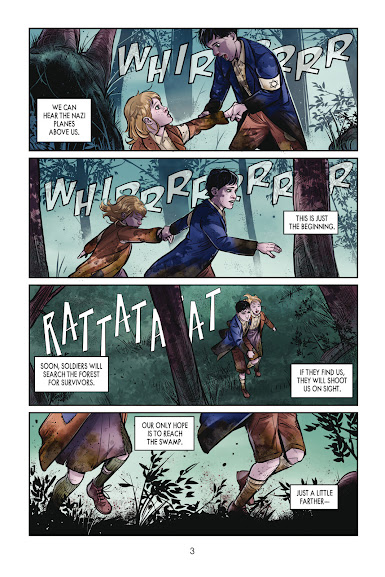When a writer begins a work of historical fiction, she must start with research. For me, that means hours of reading Holocaust websites and books.
As I mentioned in my first blog about Escape from Nuremberg, I decided to try my hand at writing a graphic novel. So, of course, that meant reading them to understand the genre. Here are the first few that I found at my library.
GAIJIN by Matt Faulkner
BOMB written by Steven Sheinkin and illustrated by Nick Bertozzi
This graphic novel adaptation of Steve Sheinkin's novel, BOMB: The Race to Build--and Steal--the World's Most Dangerous Weapon, was hard to put down. The recommended reading level is from 10-14, but it's a complicated story with flashbacks and multiple characters. I think it would be challenging for the average ten-year-old although it would show him the immense story behind the bomb's development, and probably demand a second read for true comprehension. Full of science such as physics and chemistry and history, I think it's suitable for older readers and adults as well.
BOMB is a story within a story. The "bookends" of the book are images of the FBI coming to arrest Harry Gold in May 1950 and then showing him put in prison. The story of the bomb's creation is set within the context of Harry telling the FBI agents how he leaked atomic secrets to the Soviets.
A ton of information is included: world politics and politicians, prestigious scientists who played different parts, places where the bomb was tested, the spies and unsung heroes, and the men who dropped the bomb are all mentioned. Although Sheinkin clearly shows why the bomb was developed and detonated, he and Bertozzi also show the devastation and destruction in Hiroshima and Nagasaki.
In keeping with the serious nature of the book, the colors are dark and foreboding.
 |
| BOMB_Excerpt_p62.jpg |
MAUS by Art Spiegelman
Although MAUS: A Survivor's Tale, was not written to be a graphic novel, it has become a classic that tells the Holocaust story from the perspective of a survivor (William Spiegelman) as told to his son, Art Spiegelman. Notably, it is the first comic book to win the Pulitzer Prize in 1992 and is graphic in its portrayal of the Holocaust and its effects on victims and their children.
I SURVIVED: The Nazi Invasion, 1944 from the novel by Lauren Tarshis, adapted by Georgia Ball, illustrated by Alvaro Sarraseca, and colored by Juanma Aguilera.
The ending is satisfactory as the children are reunited with their father, but the devastating effects of war are not minimized.
The graphic novel is adapted by Georgia Ball from the award-winning novel by Lauren Tarshis. The text and illustrations (by Alvaro Sarraseca and colored by Juanma Aguilera) move the story along quickly. I had read about the partisan effort in Germany, but particularly appreciated learning more about their work in Poland. The book includes back matter about the Holocaust.




_cover.jpg)






14 comments:
Thank you for sharing these books. It seems these formats are very powerful, as well as educational.
Thank you, Marci. The more I read graphic novels, the more I appreciate them!
Thanks for posting these reviews. I plan to share the book information with my foster children (13 and 14 years old) and wonder if they are mature enough to handle the content? I'll let you know.
Thanks for your comment, Barbara. Talking to them about the content and/or reading them with them would be a good idea.
Thanks for all the graphic novel recommendations. Matt's book sounds especially interesting to me.
You're welcome, Natalie. They're all good!
I hadn't heard of any of the titles you presented, although I've read quite a few in the I Survived series. I'll be sure to share your list with a with middle and high school teachers I know who teach classes about WWII. Thanks for featuring on MMGM.
Looks like you selected some great graphic novels. I too am enjoying the opportunity to read more graphic novels and love the artwork and different styles they're illustrated in.
Thanks, Brenda. yes, the artwork is amazing and type face and text--everything!
Thanks, Greg, for sharing my blog with teachers. I think these are great assets to a classroom.
Fantastic selection of graphic novels covering WW2 from different perspectives, I think Maus is very clever, but they all sound interesting. Thanks for sharing!
Thank you, Valinora! I'm learning a lot about graphic novels in this process.
All of these sound amazing. So many of my students are very into graphic novels, and this is a great way for them to learn about some events that happened in history through stories. I Survived graphic novels are very requested, and I do have this one, but have not read it yet. Thanks for sharing all of these! Lots for me to check out!
Stephanie at Fairday’s blog
Thank you for stopping by, Stephanie. Glad to have made some suggestions that might intrigue your students. Carol
Post a Comment